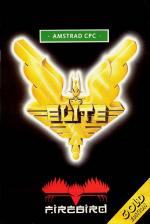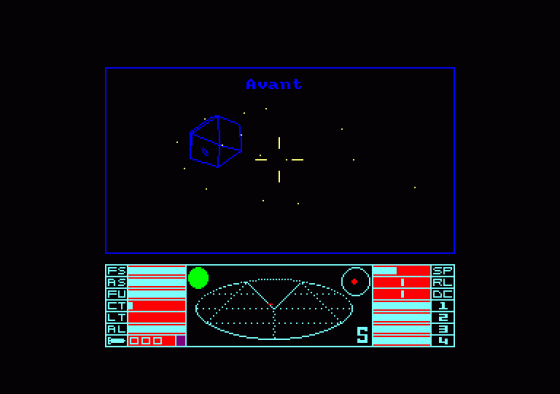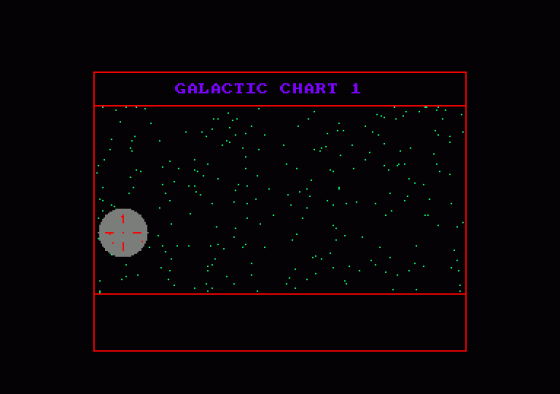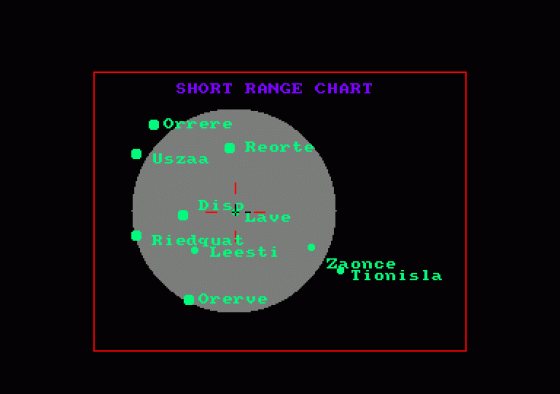
Amstrad Action
 1st February 1986
1st February 1986
Categories: Review: Software
Author: Bob Wade
Publisher: Firebird
Machine: Amstrad CPC464
Published in Amstrad Action #5
Elite
The most talked about game of 1985 has arrived and is still living up to its name by joining the elite ranks of games on the Amstrad. The game is a classic combination of trading and space shoot-'em-up action set in a massive universe of 2,000 planets and eight galaxies. It captures the attention of nearly everyone who plays it by plunging them into a world so real and absorbing that you could play it forever.
The impressive packaging is the first thing that captures the eye and imagination, presenting masses of background information, humour and atmospheric detail. The instruction booklet introduces you to the world in which you are about to be immersed and a story. The Dark Wheel sets the scene and builds up the atmosphere for the task ahead. All the controls and tasks will take a while to learn but the instructions are well-written and, despite their length, should guide you into the game quite easily.
You begin the ultimate in space adventure at a planet called Lave at the bottom left hand corner of galaxy one. From this starting point with an ill-equipped Cobra Mk III ship and only 100 credits in your pocket you have to take on the universe at trading and in battle. You'll need fuel to start your travels and after this you can launch the Cobra and practise some flying.
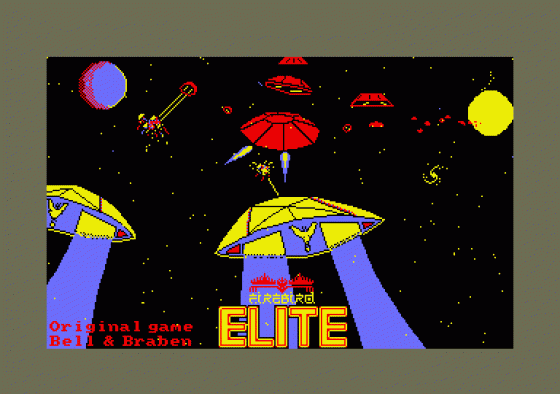
After blasting down the launching tunnel, the ship emerges to the sight of a coloured planet and space dust whizzing by. Now is your chance to get familiar with the ship's instrumentation and control, and practise docking with the space station which you just left. The flying controls and scanner may seem complicated at first but a little practice in the safety of the station area will ease a pilot into the rigours of life among the elite.
Now you should study all the scanners and information at your disposal on the various menus. In flight you can view space from forward, rear, left and right angles with space dust and all other objects visible in the relevant view. Information is also contained on the instrument panel of shield status, cabin and laser temperatures, altitude, missiles, speed, radar, attitude and power. The radar scan is the most complicated of these to understand as it presents a three dimensional view of the surrounding space but, again, practice will enable you to track objects quite successfully.
Space dust - scattered like glittering stars - is the only constant feature in the view but there are many other colourful objects that can appear. Planets and suns come in several different colours and this really brings a whole new look to the display. Not only do the planets vary in colour but so do the other ships and space stations from system to system. The ships are still line-drawn and the planets do not obscure space dust, but colour really does brighten up the view.
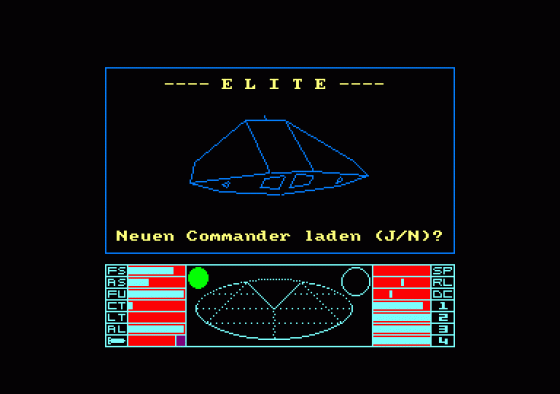
The ships in the game are all named after snakes and have a distinctive appearance from the deadly lines of the police's Vipers to the sinister Fer-de-Lance's of the bounty hunters and the evil Kraits. much loved by pirates. Some ships will be peaceful traders and won't attack but others will go after you for the cargo and the police will swarm over lawbreakers.
Most dangerous of all are the Thargoids, an insectoid race who spell instant death for most flyers and can attack in even greater numbers than the police Vipers.
The combat element is vital to success but, without good trading, it counts for little. Trading is how money is made and equipment bought, for which you need a good knowledge of the economic and social structure of the universe. Some planets are particularly good for buying and selling goods at, while some hold many dangers for the unwary pilot. For instance, computers will fetch a high price on a poor agricultural world, but it may also be an anarchist or feudal planet and therefore swarming with pirates.

As your wealth increases, new pieces of equipment can be bought to make your task easier and quicker. The aim is of course to become "Elite". You begin as "Harmless" and through surviving battles and destroying ships the rating can be increased. But beware - achieving elite status is very tough.
Within the major quest are many subsidiary steps such as gaining an expensive piece of equipment, exploring a new galaxy or completing one of the four special missions. These missions will crop up when your rating suggests you are ready to handle them but their secret nature means that you'll have to wait to find out what they are.
During any stage of the game, a number of menus can be accessed giving information on the ship's position and trading status. These are the galactic chart, short range chart, market prices and overall status information. Other menus can only be accessed when docked - these are the buying and selling of goods, and buying of equipment.
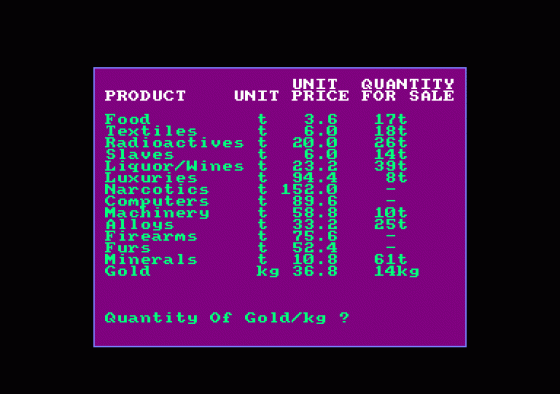
The vector graphics are excellent; smooth moving and the variety of colours makes the display superb. Many nice touches have been included such as the tunnels when entering or leaving a space station and hyperspace, and the blurring of the stars as the ship "jumps" towards a planet or sun. Most of the sound effects are disappointing but the wimpy laser sound is more than made up for by the colourful explosion of an enemy ship when you get enough hits on it. The gameplay is wonderfully addictive and really does succeed in taking you into a new world of challenge and danger.
Trading
Without good trading you won't survive for long, so It's best to work out a good strategy. Illegal goods like narcotics and slaves bring high profits but high risks as well, as the pirates and police will be after you.
Planets fall into several categories including agricultural and industrial with different technology levels and economies that affect the pricing of goods. For instance, a good profit should be made by buying computers at a high tech industrial planet and selling them at a low tech agricultural one.
Equip The Ship
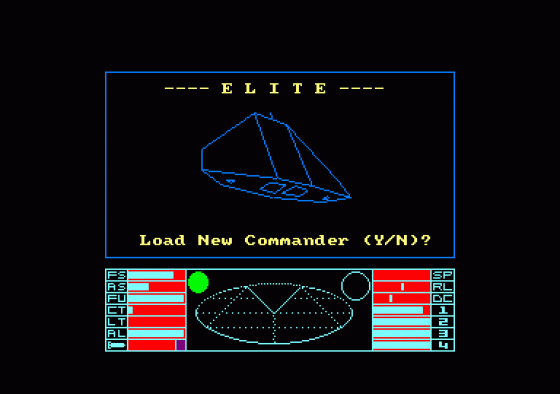
There are plenty of add-ons for your vessel, but they all cost money - some of them a small fortune.
Fuel: Needed for every trip.
Missiles: The ship can carry four, which home-in on enemy ships.
Large Cargo Bay: Enlarge cargo capacity from 20 to 35 tons.
ECM System: Defends against missiles.
Pulse Lasers: Weakest laser system.
Beam Lasers: Middle-strength laser system.
Military Lasers: Strongest lasers - very deadly (and expensive)
Fuel Scoops: Collect cargo in space and scoop fuel from suns.
Energy Bomb: Destroys all ships within scanner range of ship.
Energy Unit: Replenishes energy and shields faster.
Escape Pod: Used in emergencies to escape a doomed ship.
Docking Computer: Docks automatically at space stations.
Galactic Hyperspace: Used to get between the eight galaxies.
Second Opinion
Two or three years ago the computer games scene was flooded with tawdry little space trading games, in which you flitted around a pathetically small universe in search of goods and a little bit of fun. Sometimes you got the goods, but you hardly ever found any fun.
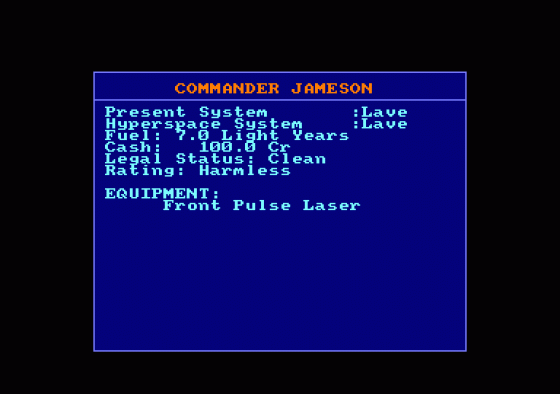
Elite has taken that very basic formula and turned it into a superbly executed and totally involving game. The idea is essentially the same, but with just about every addition you could want. Add to this the truly superb graphics, a witty scenario and some complex strategy and you have a mega-game.
It's not easy to play, and I'm still languishing as "harmless" at the bottom of the rankings so what's new? - but I know that with time and hard work I can become a contender. I will be "Elite".
Good News
P. Lots more colour than previous versions of the game.
P. Smooth vector graphics.
P. Great combination of trading and shoot-'em-up.
P. Tremendous lasting challenge to get equipment and explore universe.
P. Excellent packaging and atmosphere.
P. Four special missions.
Bad News
N. It is rather expensive.
Other Reviews Of Elite For The Amstrad CPC464
Elite (Firebird)
A review
Amstrad Collection
If you have an Amstrad computer, what games must you have? Mike Roberts looks at some of the best that we've seen.

